Added 1 new A* page:Went to a friend's poetry reading today, so I've only managed the one page. :P
Well if you're like me you're still obsessed with the situation at the tsunami-damaged nuclear power plant in Fukushima, Japan, so I'm going to keep rattling on about it and related issues! Things are not looking particularly good there: there was another fire today, and radiation levels got so bad that emergency workers had to be sent away, although apparently they're getting ready to go back--and hopefully it isn't a case of them sacrificing themselves to terminal radiation poisoning, as it was with hundreds of workers and emergency personnel in the Chernobyl disaster.
The Wikipedia page on the Fukushima plant is a good place for a concise summary of known facts. Reactors 1-3 of the plant's six reactors were online at the time of the earthquake, and there's been an explosion of superheated hydrogen gas at each of them; today's fire was at reactor 4. Reactors 1 and 2 have probably suffered damage to their fuel rods. Since the cooling systems were put out of commission by the tsunami, they've been trying to cool the overheated reactors with sea water; it's hard to tell how it's going, but it doesn't sound like it's going well (if you listen to news reports :p). And temperatures have even been rising in reactors 5 and 6.
Construction of the Fukushima plant began in 1967, so, like many nuclear plants around the world, the reactors are not of the most modern type available; reactors 1-5 have the earliest, Mark I type of containment system, and reactor 6 has a slightly more up-to-date Mark II. Still, together they can generate about 4.7 gigawatts, which puts Fukushima in the top 25 of world nuclear plants (and could power nearly five A* ship lasers! :P) in terms of power output. The reactors are "boiling water reactors"--generating power by converting water into steam, whose force is captured by turbines and converted into electricity--which are known to have a number of disadvantages; at Fukushima, these have been a) a weakness in the Mark I containment that can allow the escape of some radioactive gas in case of a coolant failure and resulting gas explosion, and b) the relatively slow cooling of water (it can take years to cool fuel rods down completely), plus the danger of boiled-off coolant water separating into hydrogen and oxygen, which are explosive in such a superheated environment.
So that's bad. None of the experts I've seen in articles or on TV appear to know just how likely a total failure and meltdown at any of the reactors is at this point, although I've seen at least some broaching the topic of "the Chernobyl option," ie entombing the damaged reactors in thousands of tons of sand, metal, and concrete...basically forever.
As it happens, we're just one month away from the 25th anniversary of the 1986 Chernobyl disaster, where reactor number 4 at that nuclear plant in what is now the Ukraine overheated during a risky systems test, and several more mistakes and miscalculations probably helped lead to a power spike, overheating, and an explosion in the reactor that damaged the control rods, enabling a huge thermal increase estimated at 30 gigawatts (10 times the plant's normal output) that quickly caused a massive steam explosion that lifted the reactor's 2000 ton covering plate, followed just a few seconds later by a much more powerful nuclear explosion of the reactor core itself; those last two explosions blew the roof off the reactor building and sent radioactive fallout over a vast area. That degree of disaster is not expected in the case of Fukushima, since Fukushima's reactors do have containment vessels--albeit old ones--while at Chernobyl there was no containment vessel at all. Still, it doesn't appear that the possibility of a massive explosion that wipes out the containment at one of the Fukushima reactors can be ruled out completely if the reactors continue heating up, and in that case you would have a large-scale release of radiation into the environment, as there was at Chernobyl (also, check out the table of radiation levels in that last Chernobyl Wikipedia link: up to 300 Sv per hour in the vicinity of the reactor, which would transmit a fatal dose within seconds; the area around unit 4 was at 10-15 Sv/hour; by contrast, the worst leak of radiation at Fukushima so far, as I mentioned in yesterday's news article--and apparently it's thanks to the failure of an upgrade to the Mark I containment, that was supposed to prevent just this thing from occurring, as the flaw in that containment type has been known for decades--was about 40 cSv (0.4 Sv) per hour: about 30 times less intense than post-explosion Chernobyl, and of a much shorter duration).
So when reactors start heading toward meltdown, you have to start thinking very seriously about encasing the damaged reactors, as was done at Chernobyl--although there it was only done after massive explosions that destroyed the reactor and reactor building completely, leaving a large pile of radioactive wreckage. I've posted some photos of the radioactive slag present at Chernobyl before; this time, I've got a sequence of the building of the wrecked Chernobyl #4 reactor's "sarcophagus" from the same US government source:
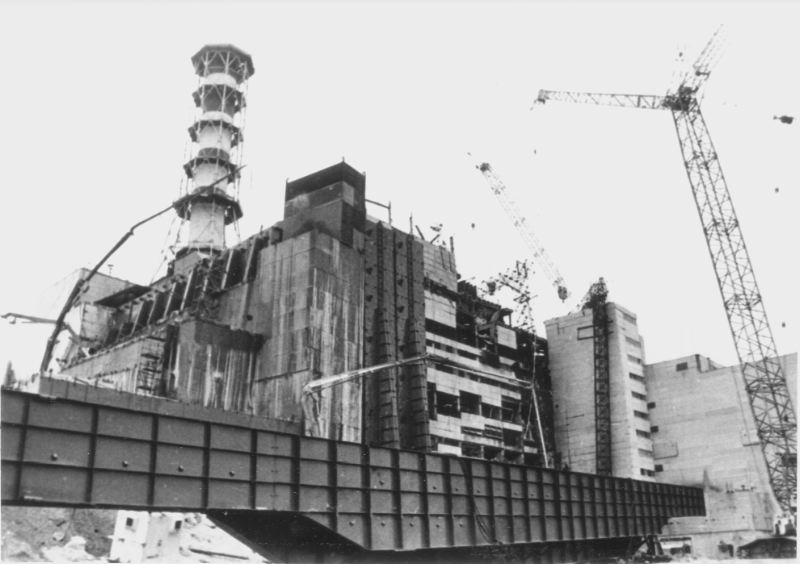
image from DOE (source)
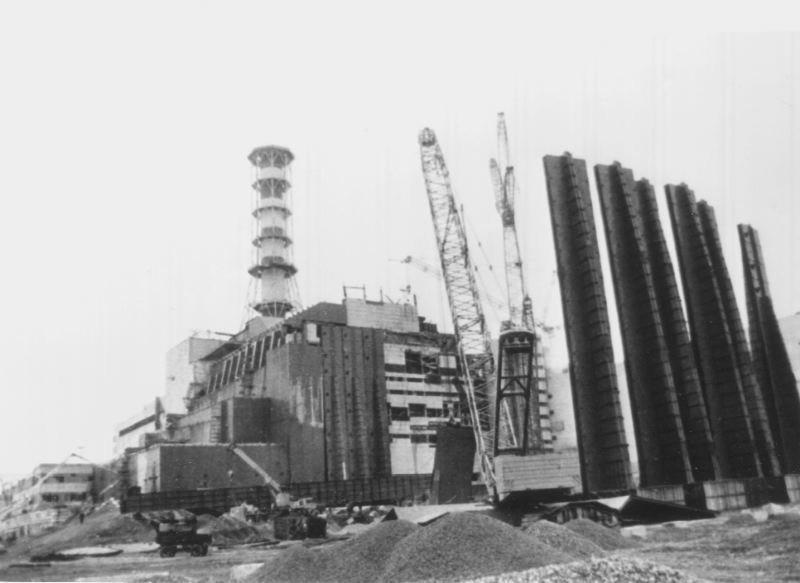
image from DOE (source)
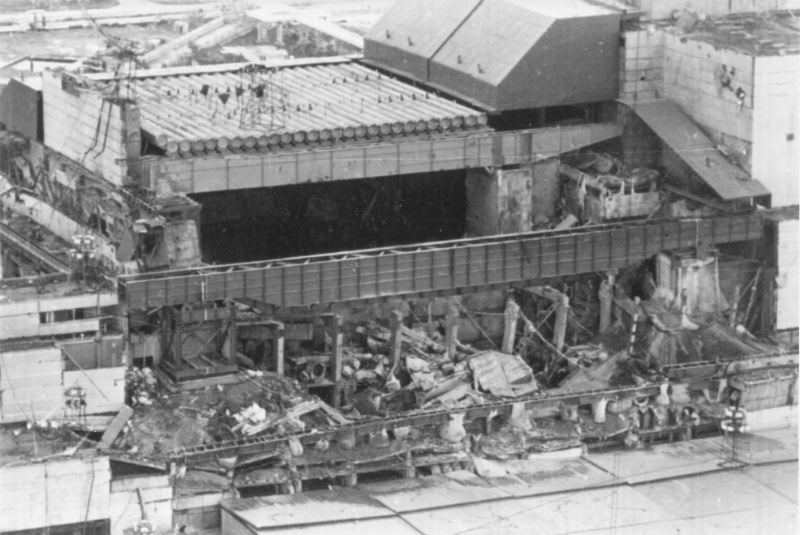
image from DOE (source)
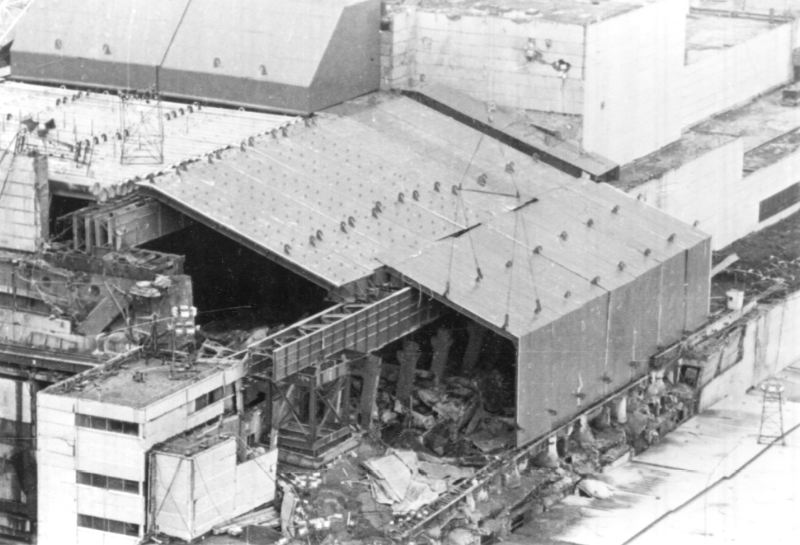
image from DOE (source)
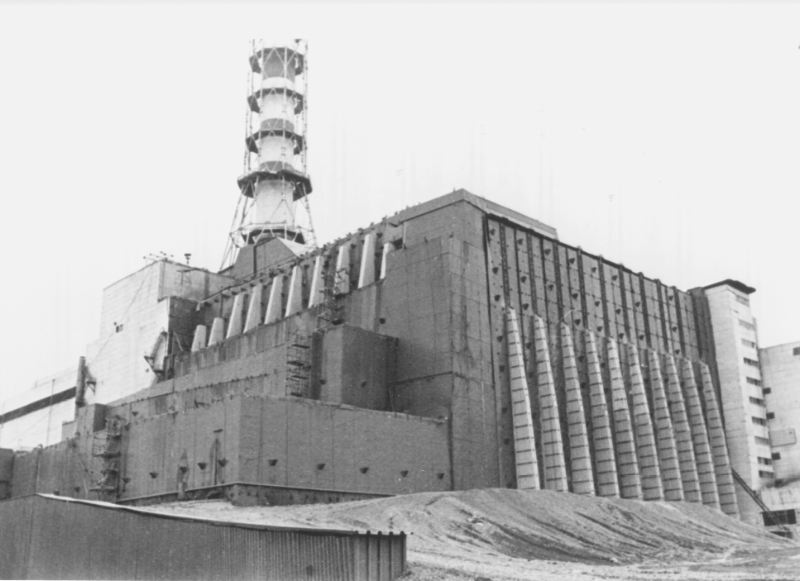
image from DOE (source)
^ That's the completed Chernobyl sarcophagus back in the day, and here it is in 1995:
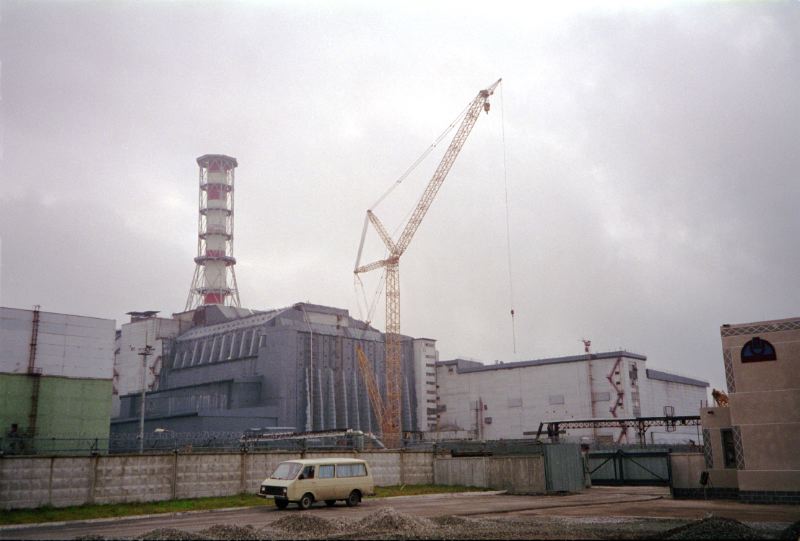
image from DOE (source)
It was constructed in emergency conditions, and relies on parts of the wrecked reactor building for support--so it is thought to be somewhat unstable. It is due to be covered over in 2013 by the New Safe Containment, a massive arched structure that will be the largest mobile structure in the world, which will encase the existing containment unit, at which point cranes and other equipment mounted on the inside of the NSC will deconstruct the unstable parts of the sarcophagus, to prevent it, hopefully, from collapsing and causing a fresh release of radioactive material from the wrecked plant. The article says the NSC is meant to contain Chernobyl for the next 100 years, at which point...I guess you make a fresh containment system and roll that into place.
Could this type of massive containment structure be the future of Fukushima?
~~~~~~~~~
Update: Thanks for forum poster Drew for linking me to this entry on the bravenewclimate.com blog which has a much more fact-based summary of the Fukushima situation than I was able to extract from news reports. And the facts seem to paint a much more positive and less catastrophic picture of the situation there, ie that it is stabilizing.
|
